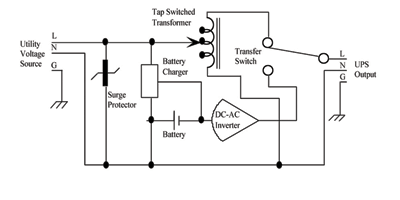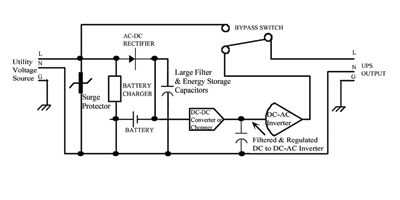The best UPS depends on the amount of protection you need
BY MICHAEL A. STOUT
Falcon Electric
Irwindale, CA
http://www.falconups.com
When uninterruptible power systems (UPSs) are discussed, most people think of the little box they purchased to provide backup power to their home or office computers. They do not think of industrial-grade power protection. However, its role in protecting critical engineering, prototyping, testing and sensitive computer equipment is a necessary security element. As with other types of security systems, the UPS is available in different grades that provide differing levels of protection.
The basic UPS topology defines the device’s protection level and determines the number and types of power quality problems a given UPS will protect against. For a UPS to be effectively implemented into today’s complex systems, the pros and cons of the differing UPS topologies must be understood.
Basic UPS topologies
There are three commonly accepted UPS design topologies: off-line, line-interactive, double conversion on-line.
The off-line UPS
The off-line or standby UPS is the least common topology found today. It is a very inexpensive backup solution for personal computers used in the home or small office environment. It is available in output capacities from 100 VA to 3 kVA and will only provide basic battery backup and limited high-voltage transient protection.
The line-interactive UPS
The line-interactive UPS (see Fig. 1 ) is the most commonly available. These devices range from inexpensive to moderately priced and are available in sizes from 100 VA up to 6 kVA. Typically designed to be used for backup and give limited power protection, they are primarily used for home and business-based computers, file-servers, and networks. In addition to battery backup and limited high-voltage transient protection, they offer limited output voltage regulation (±5 to ±12% typ) while being powered from the utility.
In the line-interactive design, utility power is fed to an auto-transformer having differing taps switched automatically by a utility voltage-sensing circuit. If the utility voltage drops too low, the transformer tap is switched to increase the UPS output voltage. If the utility voltage increases too high, another tap is selected to reduce the UPS output voltage.
Before the taps can be switched, most line-interactive designs require the UPS to switch to battery mode operation. After the tap-switch, the UPS then switches back to utility mode operation. Like the off-line UPS, when the utility and inverter switchover occurs, there is typically a 4 to 25-ms duration power loss at the output of the UPS.

Fig. 1. In the line-interactive UPS, utility power is fed to an auto-transformer having differing taps that are switched automatically by a utility-voltage-sensing circuit.
The line-interactive UPS is not the best choice for a factory or industrial environment. Power-sensitive equipment would be connected directly to raw unconditioned utility power. Even though the UPS has basic output voltage regulation, the utility-voltage-sensing circuit can become a problem.
In a harsh power environment, utility voltage fluctuations could cause the UPS to continuously switch taps in an attempt to regulate. This would again result in the batteries becoming completely discharged without allowing enough time for them to recharge.
Additionally, the increased battery cycling of the line-interactive UPS results in greatly reducing battery life and costly unscheduled battery replacements. As with the off-line, the line-interactive UPS suffers from the same 4 to 25-ms output dropout, except the dropouts would be much more numerous due to the tap-switch regulation design.
The double conversion on-line UPS
The double conversion on-line UPS (see Fig. 2 ) provides the highest level of power protection available. This UPS costs a bit more than the line-interactive. They are available in sizes from 500 VA to well over 100 kVA. The on-line design provides a much higher level of power protection and is the best choice for protecting, networks, scientific, industrial, factory automation, military, aerospace, and other mission-critical equipment.
The on-line UPS uses active electronics to continuously regenerate new ac power while operating from both utility and battery sources. The incoming ac power is rectified to a regulated dc, removing voltage transients, noise, harmonics, and frequency-related problems. This regulated dc power is then used by the continuous duty inverter circuit to regenerate clean, new ac power. The output voltage regulation is a superior ±3%.
Incredibly, when operating from a utility or generator source, the ±3% output voltage regulation is maintained over the entire input 20% to 15% voltage range of the UPS. This provides total protection from sustained utility brownouts, overvoltage conditions, noise, transients, harmonics, and frequency drift. It is like installing a firewall between the sensitive equipment and the utility power.
Most on-line-UPS manufacturers ship their units configured with the UPS output frequency synchronized with the frequency of the incoming utility power. In applications where backup generator power is being used, this may not be desirable due to frequency instability problems inherent with some generators. Some UPS models provide a fixed output frequency. This prevents the frequency drift from passing through the on-line UPS.

Fig. 2. The typical on-line design topology uses active electronics to continuously regenerate new ac power while operating from both utility and battery sources.
Some on-line UPS makers carry the non-synchronized, fixed output frequency mode operation further. They have designed their UPS to operate as a true frequency converter. Models are available that are 50-, 60-, or 400-Hz frequency converters.
When configured for this mode of operation, the UPS bypass circuitry is also disabled. Some models even allow for the removal of the UPS batteries in the event battery backup is not desired. This is a very cost-effective solution should European 50-Hz production equipment be required to operate from domestic 60-Hz power.
As the on-line UPS incorporates a continuous-duty inverter circuit it can support extended or long-term battery-mode operation. Extended battery operation of up to several hours can be realized with the addition of extended battery bank options. Off-line and most line-interactive UPS designs use limited duty inverter circuitry and will not accept additional external battery banks.
Galvanic isolation, grounding
A hostile power environment, such as a factory floor, poses additional issues. Large motors, power switching and robotics are often in abundance and often a major source of power pollution.
Microprocessor-based controllers, PLCs, and production machines are often networked or interconnected. Computerized numeric control (CNC) machines are connected to the company’s IT network and CAD workstations. This interconnectivity increases the chance of computer and network reliability problems.
Many of these problems are caused by common-mode noise or stray current flow across the interconnecting network, data, control, communications, and equipment cabling. Galvanic isolation is a solution.
Galvanic isolation is nothing more than an isolation transformer. If the transformers are installed at strategic locations, they can reduce or eliminate the troublesome current paths. Should localized galvanic isolation be required, several on-line UPS manufacturers offer models with internal galvanic isolation inside the UPS. This approach yields all of the benefits of the on-line UPS and galvanic isolation, providing a solid comprehensive solution.
Centralized UPS monitoring
UPSs can be located in a single facility or multiple facilities located around the world. Without network or Internet connectivity, the remote monitoring and management of their UPS units would be a daunting and costly process.
To solve this problem, UPS manufacturers offer SNMP/HTTP agent options. The agent may consist of a circuit card that installs inside a communications slot located somewhere on the UPS, or a standalone box that connects to the UPS RS-232 DB-9 port. The agent then connects the UPS to any 10/100-compatible Ethernet network. As the agent is TCP/IP addressable, it facilitates the remote monitoring and management of the UPS from a central location over a LAN, WAN, or the Internet.
The implementation of multiple on-line UPS units in the engineering and industrial environment provides a high level of security against the localized power quality problems typically encountered. When used in conjunction with properly distributed galvanic isolation, the combination gives the highest level of protection against the widest spectrum of power problems.
Tied with the secure high level of advanced communications, remote UPS monitoring and the ability to centralize all of the UPS management, the double-conversion on-line UPS goes far beyond battery backup. It offers secure power protection and maximizes equipment productivity and service life, while providing necessary power data and minimizing its own management costs.
For more on UPSs, visit http://www2.electronicproducts.com/Power.aspx.
Advertisement
Learn more about Falcon Electric





